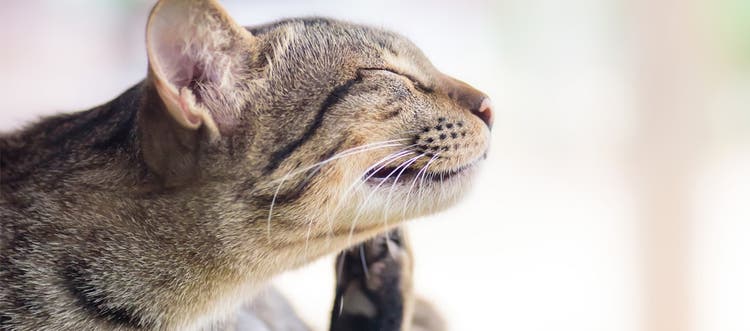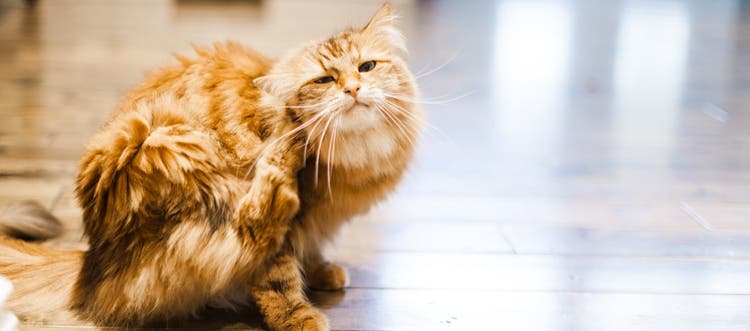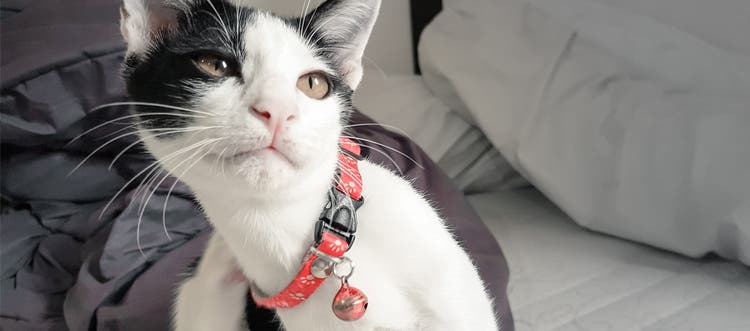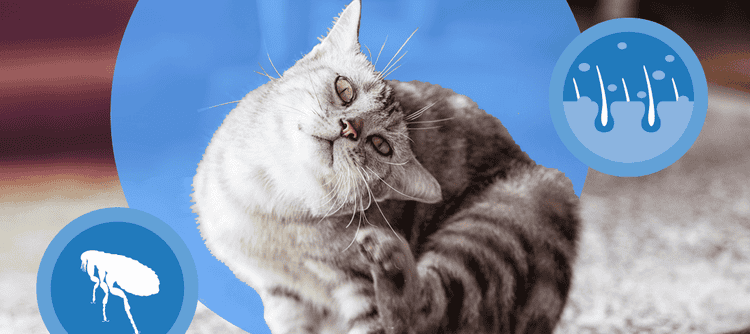What to do when your cat has fleas.
Whether your cat has been with you for years or you just adopted a new cat, fleas have a way of sneaking their way inside your home. Fleas are the number-one skin parasite of cats, and most cat owners will find these uninvited guests on their pet at one point or another — even indoor-only cats! Learn how to help get rid of fleas on cats to stop an infestation in its tracks.
How to Tell If Your Cat Has Fleas
Cats are such thorough groomers that you may not immediately notice they have fleas. Brown parasites jumping or crawling in a cat's fur are an obvious sign of fleas, but be on the lookout for these more subtle signs:
- Excessive grooming, making fleas difficult to find
- Red bumps or scabs, specifically along the neck and back
- Shaking head
- Restless or anxious behavior
- Losing fur
How to Help Get Rid of Fleas on Your Cat
Now that you've identified the cause of your cat’s discomfort, it's time to get rid of the fleas and take steps to prevent them from coming back. Did you know that the adult fleas that you can see are only a small portion of a flea infestation? The majority of fleas are hidden during immature stages as eggs or larvae that you can't see developing in and around your house, which is why it's so important to implement all the steps below.
Step 1: Treat Your Cat for Fleas
First, treat your cat with a product designed to kill fleas. Bathe your cat or kitten with a specially formulated flea shampoo to kill fleas on contact. Flea sprays can be a good option for water-averse cats. Repeat treatment as needed and recommended on the label.
Kitten flea treatment tip: Check the flea treatment label to ensure the product is safe for the age of your kitten. If your kitten is too young, contact your vet to discuss other kitten flea treatment options.
After treatment, remove fleas from your cat or kitten’s coat with a flea comb; then, dip the comb in a mixture of dish soap and water to kill any fleas left on the comb. Inspect and comb weekly to monitor the flea infestation on your cat.
Fact Check: Essential Oils for Fleas on Cats
Some online pet blogs may recommend using essential oils such as tea tree oil as a “natural” treatment for fleas. However, natural doesn’t necessarily mean harmless. Cats are more sensitive to essential oils than humans and undiluted oils can be harmful or even toxic. Essential oils and extracts are not regulated and do not require testing for safety, and it can be difficult to dilute properly.
Step 2: Use a Flea Preventive for Cats
Flea preventives help discourage fleas from coming back. Effective flea prevention options include collars, topicals and oral products that can last anywhere from 30 days to eight months. Choose the prevention method that works best for you and your cat.
Keep in mind that preventives work best when used regularly and year-round; applying for only one or two months per year could leave your pet unprotected.
Step 3: Treat All Your Pets for Fleas
If you have other cats or a dog, they could be at risk for fleas, too. Make sure to apply preventives to every pet in your home — both indoor and outdoor pets — to help keep an infestation from spreading and reduce the risk of future flea infestations.
Step 4: Treat Your Environment for Fleas
Fleas don’t have set territories and aren’t confined to your cat. Flea eggs roll off your pet and scatter throughout your home and yard. Taking a few extra steps to treat both your home and yard can further help reduce the risk of additional flea infestations.
Make an Ongoing Plan to Treat and Prevent Fleas on Your Cat
Ongoing vigilance combined with flea protection and prevention is the key to disrupting the flea life cycle. It may take a few months to end the infestation, so don’t get discouraged. Even if you continue seeing a flea or two on your cat from time to time, that doesn’t mean the products aren’t working.
To help prevent a flea infestation from returning, follow these steps:
- Check your cat at least weekly with a flea comb and look for signs of itching and scratching.
- Set reminders to apply or administer treatment and prevention products according to product labels.
- Be cognizant of your cat’s interactions with other pets, animals or people to determine the risk of catching fleas.
Finding fleas on your cat can be shocking, but even a clean home and a well-cared-for cat may still be subject to an infestation. Fleas are small but mighty. They can reproduce quickly and easily hop on other pets or wildlife, so it may take up to three months to adequately clear out the flea infestation. Help your cat by keeping a watchful eye for reinfestation, and remember to regularly use a flea preventive year-round.
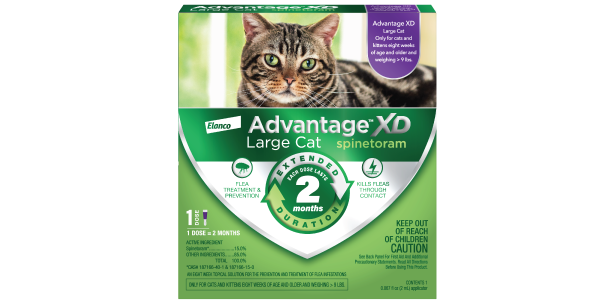
Advantage® XD (spinetoram)
Kills fleas for two months with one dose, outlasting the typical six-week flea life cycle — and the monthly competition.
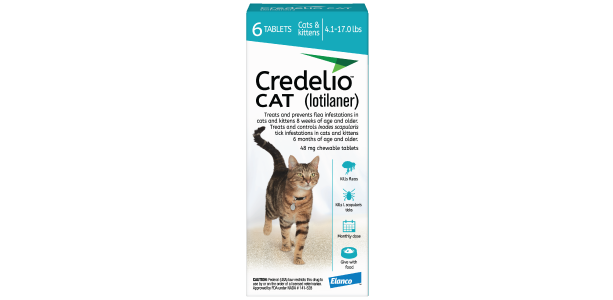
Credelio® CAT (lotilaner)
Protect your feline friend with Credelio Cat, the first and only flea and tick chewable for cats.

Seresto® Flea & Tick Collar for Cats
An easy-to-use, odorless, non-greasy collar that kills and repels fleas and ticks for 8 continuous months.

Advantage® II for Cats
A convenient, monthly topical application that kills fleas through contact so they don't have to bite your cat to die.
Credelio® CAT (lotilaner)
Indications:
Credelio CAT kills adult fleas and is indicated for the treatment and prevention of flea infestations for one month in cats and kittens 8 weeks of age and older and weighing 2 pounds or greater.
Credelio CAT is also indicated for treatment and control of black-legged tick infestations for one month in cats and kittens 6 months of age and older and weighing 2 pounds or greater.
Important Safety Information:
Lotilaner is a member of the isoxazoline class of drugs. This class has been associated with neurologic adverse reactions including tremors, incoordination, and seizures. Neurologic adverse reactions have been reported in cats receiving isoxazoline class drugs, even in cats without a history of neurologic disorders. Use with caution in cats with a history of neurologic disorders. The safety of Credelio CAT has not been established in breeding, pregnant and lactating cats. The effectiveness of Credelio CAT against black-legged ticks in kittens less than 6 months of age has not been evaluated. The most frequently reported adverse reactions are weight loss, rapid breathing and vomiting. For complete safety information, please see Credelio CAT product label or ask your veterinarian.
